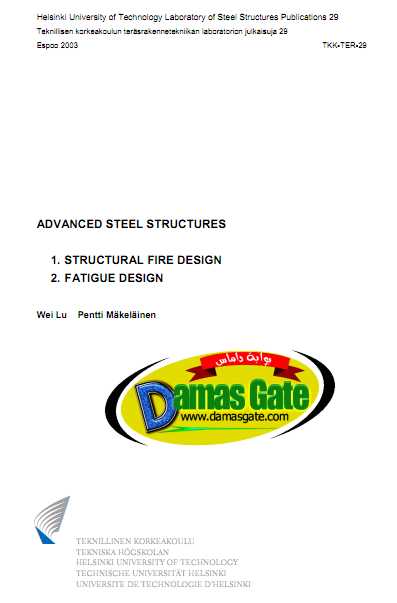Advanced Steel Structures - Fire and Fatigue Design
1 STRUCTURAL FIRE DESIGN
1.1 Introduction
1.1.1 Development of fire in buildings
A real fire in a building grows and decays in accordance with the mass and energy balance within the compartment in which it occurs. The energy released depends upon the quantity and type of fuel available and upon the ventilation conditions. Figure 1.1 illustrates that the fire in a building can be divided into three phases: the growth or pre-flashover period, the fully developed or post-flashover fire and the decay period [2]. The most rapid temperature rise occurs in the period following flashover, a point at which all organic materials in a compartment spontaneously combust. Anyone who has not escaped from a compartment before flashover is unlikely to survive.

In the pre-flashover phase, the room temperature is low and the fire is local in the compartment. This period is important for evacuation and fire fighting. Usually, it has not significant influence on the structures. After flashover, the fire enters into the fully developed phase, in which the temperature of the compartment increase rapidly and the overall compartment is engulfed in fire. The highest temperature, the highest rate of heating and the largest flame occur during this phase, which gives rise to the most structural damage and much of the fire spread in buildings. In the decaying period, which is formally identified as a stage after the temperature falling to 80 percent of its peak value, the temperature decreases gradually. It is worth to point out that this period is also important to the structural fire engineering because for the insulated steel structures and unprotected
Download
*
1 STRUCTURAL FIRE DESIGN
1.1 Introduction
1.1.1 Development of fire in buildings
A real fire in a building grows and decays in accordance with the mass and energy balance within the compartment in which it occurs. The energy released depends upon the quantity and type of fuel available and upon the ventilation conditions. Figure 1.1 illustrates that the fire in a building can be divided into three phases: the growth or pre-flashover period, the fully developed or post-flashover fire and the decay period [2]. The most rapid temperature rise occurs in the period following flashover, a point at which all organic materials in a compartment spontaneously combust. Anyone who has not escaped from a compartment before flashover is unlikely to survive.

In the pre-flashover phase, the room temperature is low and the fire is local in the compartment. This period is important for evacuation and fire fighting. Usually, it has not significant influence on the structures. After flashover, the fire enters into the fully developed phase, in which the temperature of the compartment increase rapidly and the overall compartment is engulfed in fire. The highest temperature, the highest rate of heating and the largest flame occur during this phase, which gives rise to the most structural damage and much of the fire spread in buildings. In the decaying period, which is formally identified as a stage after the temperature falling to 80 percent of its peak value, the temperature decreases gradually. It is worth to point out that this period is also important to the structural fire engineering because for the insulated steel structures and unprotected
Download
*